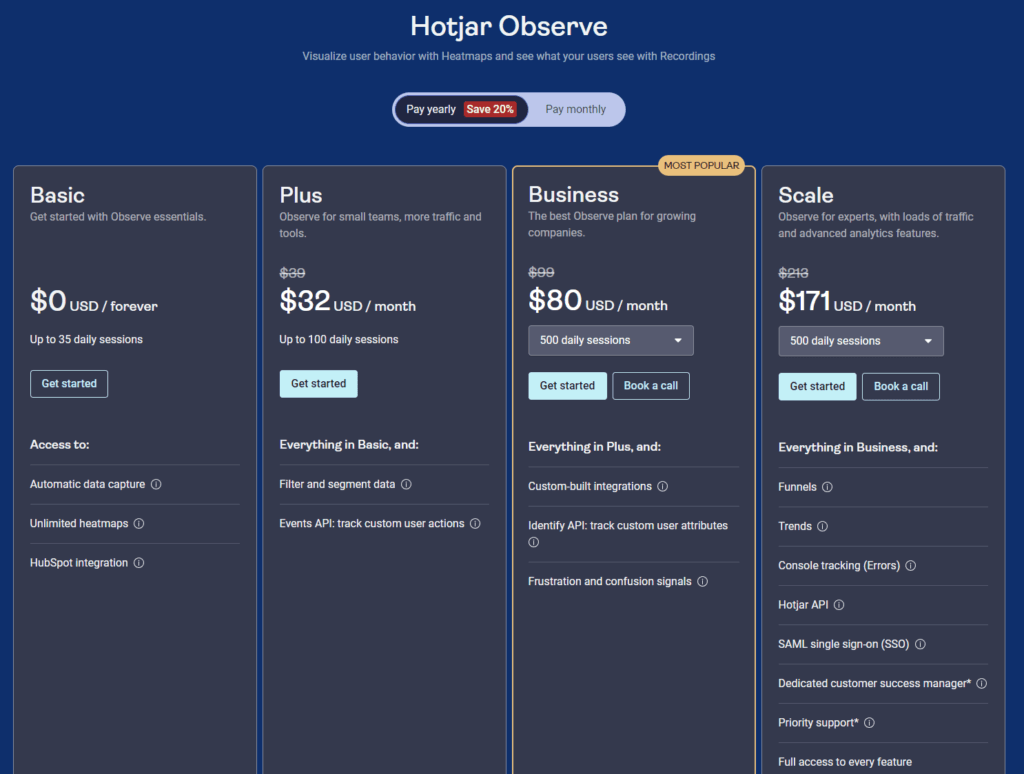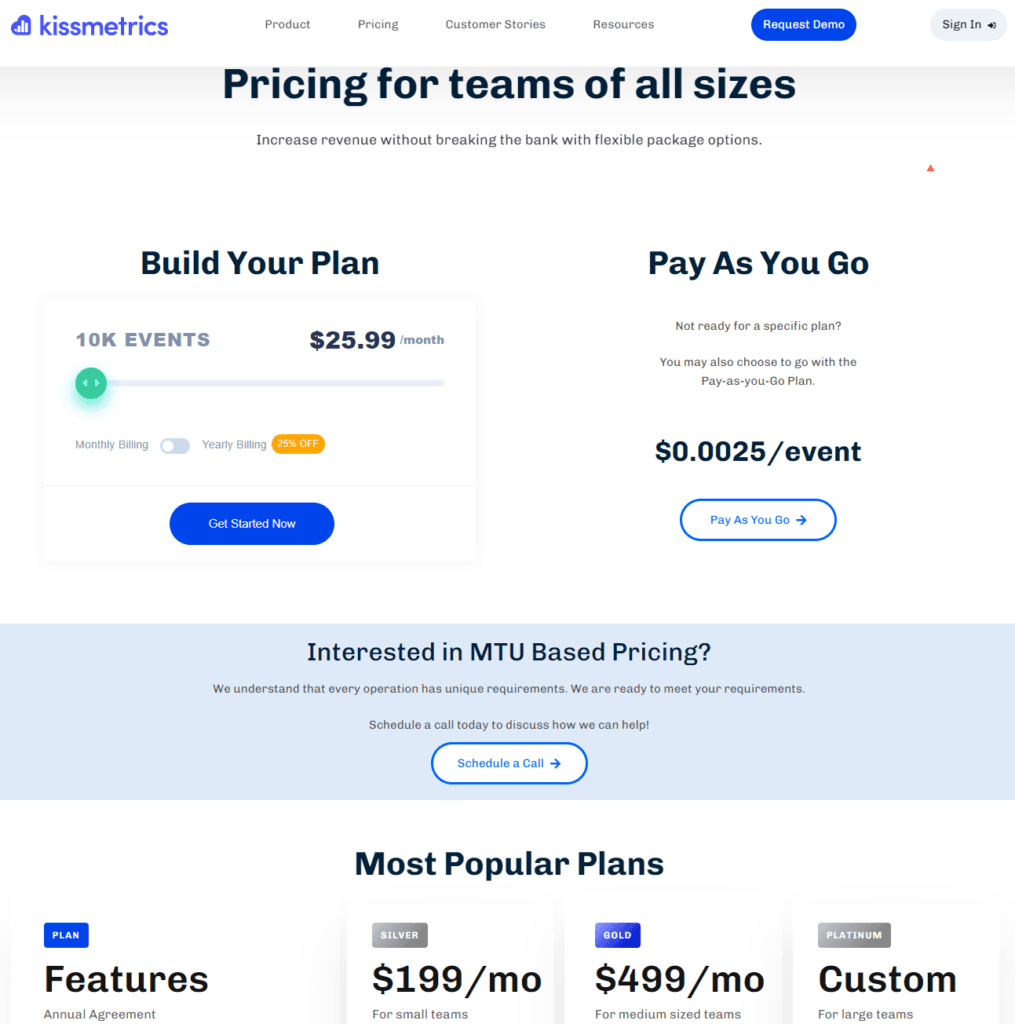In the digital age, every click, scroll, and interaction on your website holds the potential to unlock secrets to your success. But deciphering these secrets requires more than just data—it demands insight. Enter the arena two formidable contenders: Hotjar and Kissmetrics. Each tool boasts unique strengths in unraveling the mysteries of user behavior, but choosing the right partner in your quest for digital excellence can feel like navigating a labyrinth. Fear not! We’re here to light the way, comparing these titans of analytics to help you make an informed decision. So, buckle up as we dive into the crucial battle of features, usability, and impact, starting with a critical area of comparison.
| Hotjar | Kissmetrics |
|---|---|
 |  |
| G2 Score – 4.3 out of 5 stars | G2 Score – 4.1 out of 5 stars |
| TrustRadius Score – 8.2/10 | TrustRadius Score – 9.6/10 |
User Behavior Insights
The Heart of the Matter
At the core of any analytics tool is its ability to shed light on user behavior. Understanding how visitors interact with your site is key to improving user experience, increasing conversions, and ultimately driving growth. Let’s explore how Hotjar and Kissmetrics approach this pivotal task.
Hotjar: The Microscope on User Interaction
Hotjar stands out for its commitment to bringing the human element into digital analytics. By offering tools that capture not just where users click but how they navigate through a site, Hotjar provides a microscope through which businesses can observe the nuanced behaviors of their users. Heatmaps offer a color-coded visual representation, showing areas of high engagement and potential points of user frustration. Session replays take this further by allowing businesses to replay a user’s journey, offering a visual narrative of the user experience. These insights are enriched by feedback tools that directly capture user sentiments, providing a qualitative depth to the understanding of user behavior.
This suite of tools is invaluable for businesses focused on optimizing the user experience. By identifying not only what users are doing but also offering clues as to why they’re taking certain actions, Hotjar enables businesses to make targeted improvements. Whether it’s redesigning a webpage for better navigability or adjusting content to better meet user needs, the insights provided by Hotjar are actionable and directly tied to enhancing user satisfaction.
Kissmetrics: The Strategist’s Map to User Behavior
Kissmetrics offers a different lens through which to view user behavior, emphasizing the strategic application of user interaction data. This platform excels in segmenting users and analyzing their behavior over time, providing a dynamic map of user engagement across various touchpoints. By tracking users from their first interaction to the latest, Kissmetrics helps businesses understand the lifecycle of their audience, identifying patterns that lead to conversion, retention, or churn.
The power of Kissmetrics lies in its ability to distill complex user behaviors into actionable insights for strategic decision-making. For businesses looking to optimize their marketing efforts, product offerings, or overall user engagement strategies, Kissmetrics provides the data-driven foundation to do so. Customizable reports and dashboards allow businesses to tailor their analysis to specific goals, whether it’s understanding the impact of a marketing campaign or identifying the features most valued by their most engaged users.
Integration Capabilities and Ecosystem Support
In the digital age, the power of an analytics tool is not just measured by the insights it provides but also by how well it integrates with other tools and platforms within the digital ecosystem. Seamless integration enhances the utility of an analytics tool, making it a crucial factor in the decision-making process. Here, we compare Hotjar and Kissmetrics in terms of their integration capabilities and support for a broad digital ecosystem.
Hotjar: Simplifying Integration for Broader Reach
Hotjar is renowned for its simplicity and ease of use, qualities that extend to its integration capabilities. Designed to play well with a wide range of platforms, Hotjar offers straightforward integration options with popular website builders, CMS platforms, and e-commerce systems. This ensures that regardless of the technology stack a business is using, incorporating Hotjar into the mix is hassle-free and doesn’t require extensive technical know-how.
Moreover, Hotjar’s focus on user experience insights makes it a valuable complement to quantitative data analytics tools. Its ability to integrate with platforms like Google Analytics allows businesses to marry quantitative data with qualitative insights, providing a holistic view of the user experience. This synergy between tools enriches the data ecosystem, empowering businesses to make well-rounded decisions based on both numbers and real user feedback.
Kissmetrics: Deep Integration for Data-Driven Strategies
Kissmetrics, on the other hand, takes a more focused approach to integration, emphasizing depth over breadth. It provides robust integration options with a variety of marketing, sales, and product tools, enabling businesses to dive deep into customer behavior analytics. Kissmetrics shines in its ability to feed detailed user data into the broader business intelligence ecosystem, offering integrations that allow for sophisticated tracking and analysis across multiple touchpoints in the customer journey.
This emphasis on deep, meaningful integration supports businesses in constructing a data-driven strategy that’s informed by detailed analytics at every stage of the funnel. Whether it’s understanding the nuances of user engagement, optimizing conversion paths, or personalizing marketing efforts, Kissmetrics ensures that every piece of data can be seamlessly connected and analyzed within the larger digital strategy framework.
Customer Support and Community Engagement
Nurturing Success
In the digital age, where analytics tools can significantly influence the trajectory of your business, the level of customer support and the vibrancy of the community surrounding a tool are more than just added benefits—they’re lifelines. Hotjar and Kissmetrics not only offer insights into user behavior but also provide support ecosystems to help businesses thrive. Let’s delve into how each platform approaches customer support and community engagement.
Hotjar: Personalized Support and a Thriving Community
Hotjar emphasizes a personal touch in its customer support, offering timely and responsive assistance to ensure users can make the most of its features. Whether it’s through email or an extensive online knowledge base filled with guides, FAQs, and tutorials, Hotjar ensures users have the resources they need to solve any issues they encounter. This commitment to accessible support helps users of all skill levels, from beginners to seasoned analysts, leverage Hotjar’s capabilities to their fullest.
Beyond individual support, Hotjar fosters a vibrant community of users. Through forums, social media groups, and regular webinars, Hotjar encourages users to share insights, ask questions, and learn from each other. This community aspect is invaluable, as it not only helps users solve practical problems but also inspires new ways to use Hotjar to uncover user insights and improve website performance.
Kissmetrics: Data-Driven Support and Educational Resources
Kissmetrics, known for its deep analytical capabilities, extends its data-driven approach to its customer support and educational resources. The platform offers detailed support documentation, video tutorials, and case studies designed to help users navigate its comprehensive suite of analytics tools. Kissmetrics’ support team is also known for its expertise, providing targeted advice to help businesses tailor the platform to their specific needs.
In addition to direct support, Kissmetrics offers a wealth of educational content aimed at helping businesses understand not just how to use the platform, but how to think about and implement data-driven strategies effectively. Through blog posts, e-books, and webinars, Kissmetrics educates its users on best practices in analytics, conversion optimization, and marketing strategy, reinforcing its role as a tool for strategic growth.

Related: Check out our free SEO suite

Flexibility and Customization
Tailoring the Tool to Your Needs
The ability of an analytics platform to adapt to the unique requirements of a business significantly enhances its value. Flexibility in data collection, analysis, and reporting, as well as customization in what data is tracked and how insights are presented, can make a substantial difference in the utility of the tool. Let’s examine how Hotjar and Kissmetrics stack up in these areas.
Hotjar: User-Centric Flexibility
Hotjar’s platform is designed with a focus on ease of use and immediate insights into user behavior. While it offers considerable flexibility in how data is collected and presented, its strength lies in providing a set of straightforward, effective tools that require minimal customization to start delivering value. Heatmaps, session recordings, and feedback polls are intuitively designed, allowing businesses to quickly set up and start gathering user insights with little need for customization.
That said, Hotjar does offer some flexibility in targeting specific user segments for feedback and recordings, as well as customizable survey questions. This allows businesses to tailor their data collection to some extent, focusing on the areas of their website or app that are most critical to their user experience and conversion goals.
Kissmetrics: Deep Customization for Strategic Insights
Kissmetrics distinguishes itself with a robust set of customization options, reflecting its focus on providing deep, actionable insights into user behavior and business metrics. The platform allows businesses to define custom events and properties, giving them the flexibility to track exactly the data that matters most to their specific objectives. This level of customization extends to Kissmetrics’ reporting features, where users can create detailed, custom reports and dashboards that align with their strategic goals.
Furthermore, Kissmetrics’ segmentation capabilities enable businesses to drill down into their data, analyzing behavior and performance across different user segments, channels, and campaigns. This customizable analysis is crucial for businesses that rely on nuanced insights to inform their marketing strategies, product development, and customer engagement efforts.
Data Ownership and Privacy
Securing User Trust
Both Hotjar and Kissmetrics collect extensive user data to provide insights into behavior and performance. However, the manner in which they manage, secure, and utilize this data can significantly impact user trust and compliance with global privacy laws.
Hotjar: Prioritizing User Privacy and Simplicity
Hotjar places a strong emphasis on user privacy, offering features designed to protect user data and ensure that businesses using its platform can easily comply with privacy laws like GDPR, CCPA, and others. Hotjar provides options to anonymize user data, ensuring that personally identifiable information (PII) is not inadvertently captured during session recordings or through feedback forms. This focus on privacy makes Hotjar an appealing option for businesses concerned with maintaining user trust and adhering to privacy regulations.
Moreover, Hotjar’s approach to data ownership is transparent and straightforward, allowing businesses to maintain control over their data. They offer clear guidelines on how data is collected, stored, and used, ensuring businesses can make informed decisions about their data practices.
Kissmetrics: Leveraging Data for In-depth Insights
Kissmetrics, known for its comprehensive analytics capabilities, also recognizes the importance of data privacy and security. The platform is designed to provide detailed insights while ensuring that data handling practices align with privacy regulations. Kissmetrics allows businesses to track user interactions across multiple touchpoints without compromising on privacy, employing methods to safeguard user data and provide businesses the ability to operate within the framework of global data protection laws.
The platform’s data ownership model is built around empowering businesses with data-driven insights while ensuring that the collection and use of data are transparent and compliant with privacy standards. Kissmetrics provides robust data management tools that help businesses segment and analyze data in a secure environment, maintaining the confidentiality of user information.
Pricing
Hotjar

Kissmetrics

Conclusion
Hotjar emerges as a beacon for businesses keen on diving deep into the qualitative aspects of user behavior. Its suite of tools, designed to capture the subtleties of user interactions through heatmaps, session replays, and direct feedback, offers invaluable insights for enhancing the user experience. Hotjar is particularly suited for teams looking for an intuitive, straightforward solution to make immediate improvements to their websites and digital products, focusing on the human element behind the clicks.
Kissmetrics, on the other hand, offers a strategic vantage point, emphasizing quantitative analysis to drive data-informed decisions across the business spectrum. With its robust segmentation, tracking, and reporting capabilities, Kissmetrics is the tool of choice for businesses that prioritize a comprehensive understanding of their users’ journeys. It stands out for those ready to integrate deep behavioral insights into their broader marketing strategies, product development, and customer engagement efforts, offering a granular view of user interactions over time.
Read Next:
- International Backlink Strategies for Biotech Startups
- Navigating Regional SEO for Lifesciences: Our Take!
- Optimizing Multilingual Content for Biotech Firms: Fast and Easy‘
- Taking Your Biotech Company Global with SEO: (Our Process!)






















Comments are closed.